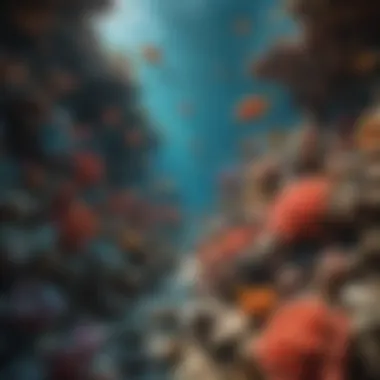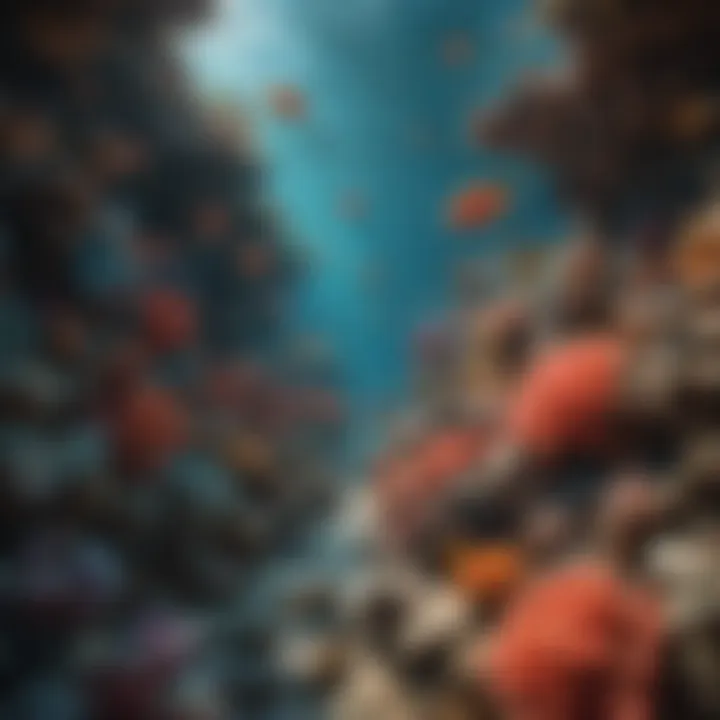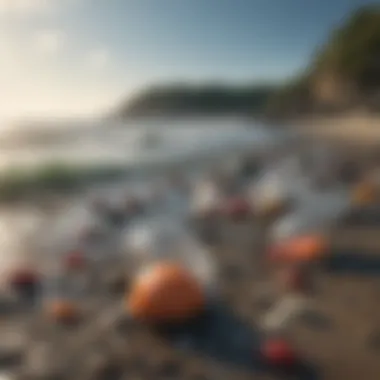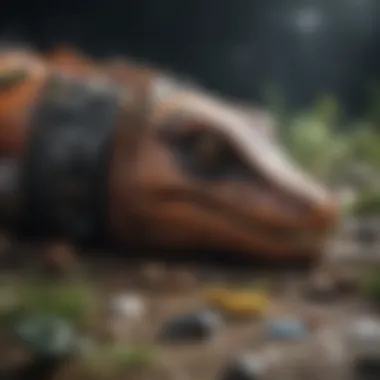Impact of Plastic Pollution on Ecosystems and Health


Intro
Plastic pollution is not just a nuisance; it’s a far-reaching environmental issue that intertwines itself with various facets of life on Earth. As communities embrace convenience, plastics have woven themselves into the very fabric of modern society. Yet, behind their convenience lies a dark reality. The persistent nature of plastic means it doesn't fade away quietly. Instead, it breaks down into smaller particles, causing havoc in ecosystems across the globe.
This exploration of how plastic pollution affects the environment takes us through a labyrinth of complex interactions. From the vast oceans to the smallest insects, plastic's impact is felt everywhere. As we embark on this journey, it becomes crucial to understand what lies beneath the surface of these issues and consider the urgent need for sustainable practices.
Research Overview
Summary of Key Findings
Research into the plastic pollution crisis has yielded a treasure trove of insights. Here are some striking points:
- Plastic waste is estimated to account for 60-90% of all marine debris.
- Microplastics have infiltrated food chains, affecting both aquatic life and human health.
- A staggering reduction in biodiversity is linked to habitats being burdened by plastic waste.
The science is clear: plastic pollution is not only an aesthetic issue but a fundamental threat to ecological balance.
Background and Context
Understanding plastic pollution requires a look at its background. The massive increase in plastic production since the 1950s has created an unprecedented amount of waste. According to data, approximately 400 million tons of plastic are produced annually. A significant portion of this ends up in landfills, waterways, and oceans, exacerbating the problem.
Moreover, as plastic waste lingers, it can fragment into microplastics, which are tiny particles that escape conventional waste management systems. These microplastics often hitch a ride on marine life, posing danger not only to wildlife but to human beings as they enter the food chain.
"Plastic pollution encapsulates one of the most pressing environmental challenges of our time, affecting biodiversity, human health, and global ecosystems."
As we piece together the pieces of the puzzle that plastic pollution presents, the urgency of addressing this matter intensifies. It crops up in discussions of ecological sustainability, ethics, and public health. Environmental advocates call for changes not just from industries but also from individuals as they navigate their consumption habits.
This summary establishes a foundation as we delve deeper into how plastic manifests within ecosystems, disrupts food webs, and the pathways through which it finds its way into each aspect of our lives.
Prelude to Plastic Pollution
Plastic pollution stands as one of the pressing challenges faced by our planet today. As we delve into this topic, it becomes evident that the scope and implications of plastic waste extend far beyond our immediate surroundings, penetrating ecosystems and altering natural balances. This introduction aims to highlight the significance of understanding plastic pollution and its far-reaching effects.
The essence of tackling plastic pollution lies in recognizing its multifaceted nature. From landfill overflow to the inundation of our oceans, plastics unleash a cascade of environmental repercussions. Current research indicates that more than 300 million tons of plastic are produced annually, with a substantial proportion ending up in landfills or, worse yet, our oceans.
Addressing this issue means grappling with its complexity and urgency; every piece of plastic that finds its way into the environment intensifies the threat to marine life, soil quality, and ultimately, human health. Moreover, the societal and economic repercussions are staggering, affecting industries ranging from tourism to fisheries. By focusing on plastic pollution, we can catalyze discussions, strategies, and solutions that foster a healthier planet.
Definition and Scope
To combat the challenges posed by plastic pollution effectively, we must first define what we mean by the term. Plastic pollution refers to the accumulation of plastic materials in the environment that adversely affect wildlife, wildlife habitats, and humans. The scope of this issue includes not only the large visible items we often associate with pollution, like bottles and bags, but also the less noticeable, smaller pieces known as microplastics.
Microplastics, which are fragments less than five millimeters in size, stem from various sources, such as the breakdown of larger plastic debris or the shedding of synthetic fibers during washing. They are ubiquitous and, alarmingly, have been found in organisms at all levels of the food chain, highlighting the pervasive nature of plastic contamination.
Historical Context
The historical context of plastic pollution provides insight into how we arrived at this juncture. The ascent of plastics as a ubiquitous material began in the early 20th century, primarily due to their versatility and lightweight nature. By the 1950s, a boom in plastic production exploded, driven by post-war manufacturing and consumer demand. However, the manufacturers of these products scarcely considered the environmental ramifications of their widespread use.
As the decades rolled by, innovations in packaging and product design led to a sizable increase in single-use plastics. Fast forward to the late 20th and early 21st centuries, and the harsh reality of this preference hit home: oceans and landscapes overwhelmed by discarded plastic.
"Until we face the fact that effective plastic waste management is not just a challenge but a necessity, we will drown in our waste," said a prominent environmentalist.
Thus, understanding the historical evolution of plastic usage and disposal practices is crucial for grasping current challenges and formulating effective responses.
This exploration brings us one step closer to dissecting the critical elements of plastic pollution and its environmental canvas, setting the stage for further examination of its far-reaching effects.
Sources of Plastic Pollution
Understanding the sources of plastic pollution is crucial in the effort to mitigate its impact on the environment. By identifying where plastic waste comes from, we can devise more effective strategies to combat its spread. It encompasses a range of elements, from industrial processes to personal habits, all contributing to the collective burden that plastic imposes on ecosystems.
Industrial Contributions
The industrial sector is a major player in the plastic pollution crisis. Factories produce vast amounts of plastic products and packaging, often without adequate measures for waste management.
- Manufacturing Process: The creation of plastic starts with the extraction of raw materials, primarily petroleum products. During the production phase, leftover scraps and defective products often end up in landfills or are improperly disposed of.
- Transportation and Packaging: Once produced, plastics need to be transported. This process generates additional waste. For instance, single-use wrappers and pallets may be discarded rather than recycled.
"The sheer scale of plastic production means that even small inefficiencies can translate into significant waste."
These practices not only contribute to pollution but also create long-term environmental consequences. When these plastics eventually find their way into waterways, they can break down into smaller fragments, complicating the pollution scenario even further.


Household Waste
The contribution of households to plastic pollution cannot be overlooked. Daily activities yield a staggering amount of plastic waste, primarily from consumer goods and packaging.
- Single-Use Plastics: Items such as grocery bags, straws, and packaging materials are commonly used but often discarded after a single use, contributing to long-lasting litter.
- Consumer Convenience: A societal shift towards convenience has led to a surge in plastic usage. Takeout containers and disposable utensils from restaurants can pile up quickly, creating significant waste.
- Lack of Recycling Knowledge: Many people are unaware of proper recycling practices, leading to an increase in contamination in recycling streams.
To tackle this issue, we need awareness campaigns that emphasize the importance of responsible consumption and disposal habits.
Microplastic Generation
Microplastics have emerged as one of the more insidious aspects of plastic pollution. These tiny particles, generally smaller than 5 millimeters, are not just a byproduct; they are often created through various unnatural processes.
- Breakdown of Larger Plastics: As larger plastic items degrade—due to weathering, abrasion, or sunlight—they fragment into microplastics. This process can take many years, leading to long-term pollution in ecosystems.
- Synthetic Textiles: Washing machines discharge microfibers from synthetic clothing during laundry. Each wash can release thousands of fibers into wastewater systems, which often do not filter out these pollutants effectively.
- Cosmetic Products: Some personal care items contain microbeads, tiny plastic particles used for exfoliation. These beads bypass water treatment plants, ending up in oceans and rivers.
The widespread nature of microplastics makes them particularly challenging to address, as they infiltrate every aspect of the environment, from the deepest ocean trenches to the air we breathe.
By understanding these various sources of plastic pollution, we can start to devise strategic responses that encompass both individual actions and industrial regulations. Each step towards reducing plastic waste brings us closer to healthier ecosystems and a sustainable future.
Impact on Marine Ecosystems
The oceans cover over 70% of our planet and play a crucial role in regulating climate and supporting life. Yet, they face significant threats due to plastic pollution. Understanding how this pollution impacts marine ecosystems is vital, as it leads to a ripple effect influencing biodiversity, food chains, and even human health. Factors such as the type, volume, and distribution of plastics can have profound implications on marine habitats, making this topic crucial not only for environmentalists but also for those concerned about sustainability and the future of our planet.
Disruption of Marine Biodiversity
Marine biodiversity is the variety of life in our oceans. It includes everything from tiny plankton to the mighty blue whale, each playing an integral role in the oceanic balance. Plastic pollution disrupts this balance in several ways. When plastic waste enters the oceans, it can lead to the entanglement and death of countless marine species. For instance, sea turtles often mistake plastic bags for jellyfish, which they typically eat. This can result in lethal digestive blockages.
Moreover, plastic debris serves as a substrate for invasive species, allowing them to hitch a ride across oceans and occupy new territories. These invaders can outcompete native species for resources, further diminishing biodiversity. By choking off the myriad relationships among species, the disruption cascades through the ecosystem.
Effects on Coral Reefs
Coral reefs are often termed the “rainforests of the sea” due to their rich biodiversity. However, plastic pollution poses a significant threat to these fragile ecosystems. Large pieces of plastic can smother coral reefs, blocking sunlight and hindering their ability to perform photosynthesis.
Additionally, smaller plastic particles, known as microplastics, can infiltrate coral tissues, leading to diseases. Corals stressed by pollution are less resilient to climate change effects, such as increased temperatures and ocean acidification. As coral reefs decline, the numerous species that depend on them for habitat and protection face dire consequences, which can result in further losses in marine biodiversity.
Bioaccumulation in Marine Food Chains
Bioaccumulation refers to the buildup of substances, like plastics, in the tissues of living organisms. In marine food chains, when smaller organisms, such as fish and crustaceans, ingest microplastics, they accumulate in their bodies over time. Larger predators that consume these smaller creatures, such as sharks, seabirds, and even humans, then also ingest plastics indirectly.
This bioaccumulation can have harmful implications not only for marine life but also for human health. Chemicals associated with plastics, such as bisphenol A (BPA) and phthalates, can disrupt hormonal systems and trigger various health issues. The long-term consequences are still under research, but the potential risks make it necessary for increased monitoring and regulatory measures to manage plastic pollution effectively.
"The disruption of marine ecosystems through plastic work hand in hand with bioaccumulation; both urgent issues call for immediate global attention."
Effects on Terrestrial Ecosystems
Plastic pollution doesn’t just make our oceans look like a landfill—it wreaks havoc on terrestrial ecosystems as well. It's crucial to grasp this strain because it extends beyond the mere visual degradation of our landscapes. Terrestrial ecosystems are vital for biodiversity, carbon storage, and the overall health of the planet. Understanding the effects of plastics here can expose an often-overlooked side of the pollution issue that impacts everything from soil health to our future food supplies.
Soil Contamination
Soil is the foundation of terrestrial ecosystems. It supports plant life, which in turn sustains numerous organisms. However, plastic waste disrupts this delicate balance, infiltrating soils and altering their composition. When plastics break down, they can release harmful chemicals into the soil. These compounds may include heavy metals and additives like phthalates and bisphenol, which have been linked to severe health problems in various organisms.
"Plastics do not decompose like organic matter; instead, they break into smaller pieces, creating microplastics that contaminate the soil and can be absorbed by plants."
This soil contamination can have several significant repercussions:
- Nutrient Deficiency: Microplastics absorb nutrients and exchange them in the soil, leading to nutrient-poor substrates that no longer support healthy plant growth.
- Soil Structure Deterioration: The physical presence of plastic can disrupt soil aggregates, causing erosion and reducing water retention, which ultimately diminishes soil health.
- Toxic Accumulation: Over time, these toxic substances can accumulate, affecting not just the immediate area but spreading across larger geographical regions, potentially impacting food crops and pastures.
Impact on Plant Life
Plants play a central role in any ecosystem by providing oxygen, food, and habitat for numerous organisms. Plastic pollution can substantially hinder plant health and growth in diverse ways. The presence of microplastics in soil affects not only the plants themselves but also their interactions with other elements of the ecosystem.
Some key impacts include:
- Growth Inhibition: Research has demonstrated that microplastics can lead to stunted growth in plants. These materials inadvertently affect water and nutrient uptake, leading to less vigorous plant life.
- Altered Microbial Communities: Soil microorganisms are fundamental for nutrient cycling. Plastics can compromise these communities, leading to imbalances that may affect soil fertility and plant health.
- Chemical Leaching: Plastics can leach harmful chemicals that may interfere with plant hormones, which are essential for growth and development, creating a ripple effect in the food web.
In summary, the effects of plastic pollution on terrestrial ecosystems are profound and multi-layered. Soil contamination leads directly to challenges in maintaining healthy plant life, which in turn can have cascading impacts throughout entire ecosystems. It's clear that addressing plastic pollution is not just an ocean concern; it is a land-based issue that demands urgent attention.
Human Health Implications
The effects of plastic pollution extend far beyond the confines of natural environments, reaching deeply into the realm of human health. As the planet grapples with increasing levels of plastic waste, it becomes crucial to examine how these materials, often invisible to the naked eye, affect our wellbeing. The presence of plastics in our surroundings and bodies raises significant concerns regarding toxicity, bioaccumulation, and long-term consequences that are only starting to come into focus.


Toxicity of Plastic Additives
Plastics aren’t just benign materials; they’re often cocktail drinks mixed with various additives that can have harmful effects on health. Chemicals like bisphenol A (BPA) and phthalates are commonly used to enhance plastic durability and flexibility. Unfortunately, these substances can leach into food, beverages, and even the air we breathe. Vulnerable populations, especially children and pregnant women, are at heightened risk due to their developing bodies.
"Studies have shown that exposure to these additives can disrupt hormones, affect brain development, and potentially lead to chronic health issues like obesity and diabetes."
Identifying the sources of these toxins is only half the battle. The real challenge lies in understanding their cumulative effects over time. When plastics degrade, they release harmful substances that can accumulate in the human body, leading to long-lasting health implications. Hence, the everyday items we use, like plastic bottles or containers, could harbor unseen threats lurking in plain sight.
Effects of Microplastics on Human Health
Microplastics, those tiny particles less than five millimeters in size, have infiltrated various environmental systems, including air, water, and even food sources. Emerging research indicates that humans are increasingly exposed to these particles, raising alarms about potential health impacts. Clinical studies suggest that microplastics can be absorbed through ingestion and inhalation, potentially leading to direct toxic effects on human tissues.
Some critical points to consider regarding microplastics and human health include:
- Inflammation Response: Microplastics can trigger inflammation in human tissues, potentially leading to various health complications.
- Chemical Leaching: Microplastics can carry harmful chemicals and pathogens, amplifying the risk of disease transmission.
- Immune System Effects: Repeated exposure may weaken immune responses, making individuals more susceptible to infections and diseases.
As scientific inquiry into this subject intensifies, it's becoming clear that the associations between microplastics and human ailments must not be overlooked. Conducting further research is vital to uncovering the full scope of risks that microplastics pose to public health. The findings will ultimately inform policy decisions and public health strategies aimed at mitigating these risks and promoting healthier environments.
Economic Consequences
Understanding the economic consequences of plastic pollution is crucial because it extends beyond environmental and health impacts; it affects communities, industries, and governments that are all navigating this modern crisis. The economic burden associated with plastic waste translates into significant clean-up costs, diminished productivity in vital sectors like fisheries and tourism, and ultimately, a decrease in quality of life. These ramifications ripple through not just local economies but global markets, demanding urgent attention and action from all stakeholders involved.
Cost of Clean-Up Efforts
When plastic waste accumulates on landscapes or waterways, municipalities often face substantial clean-up bills. For instance, beach clean-up initiatives, which are often conducted by local authorities, can run tens of thousands of dollars annually. The costs involved include labor, equipment, and disposal of waste, not to mention the hidden costs of lost tourism revenue during clean-up operations.
Moreover, such clean-up efforts can draw much-needed resources away from other vital programs in a community, posing further economic challenges. Businesses that rely on the natural beauty of their environment may experience a downturn in visitors if local sites become polluted. It's like a snowball effect: one clean-up leads to another need, with funds stretching thinner each year.
Here's a small snapshot of key costs involved:
- Labor Costs: Wages for workers undertaking removal operations, often supplemented by volunteers who bring their own tools.
- Equipment Costs: Specialty tools and vehicles for transportation and disposal of large plastic items.
- Waste Disposal Fees: Municipalities face fees for landfill disposal or recycling, which can escalate based on the volume of collected waste.
"The financial burden is unsustainable if we don’t act quickly to reduce plastic entering our ecosystems."
– Environmental Economist
Impact on Fisheries and Tourism
Both fisheries and tourism are significantly aware of their environmental surroundings, and plastic pollution can drastically impact these sectors. Any delays or disregard for this issue can lead to a cumulative decline in fish populations and tourist activities.
- Fisheries: The effects on fisheries are twofold. Firstly, fish often mistake plastic debris for food, leading to ingestion that can harm fish health and accumulate toxins within the food chain. Consistency in fish populations is disrupted by not only physical harm but changes in reproductive patterns. This results in reduced catches, impacting the livelihoods of fishermen.
- Tourism: Tourists flock to pristine beaches and clear waters, which are threatened by litter and waste. When plastic pollution tarnishes a destination, visitors may think twice about returning. This decline can affect local economies that depend on tourism revenue, resulting in job losses and lowered income.
Here’s how this plays out:
- Fisheries revenues decrease due to lower yield and increased effort needed to catch the same amount of fish.
- Tourist satisfaction drops, leading to reduced reviews and less word-of-mouth promotion.
Both sectors require a collaborative approach to safeguard not just their immediate economic interests but also the health of marine ecosystems.
In summary, the economic consequences of plastic pollution present a multifaceted challenge that stretches far beyond simple waste management. Addressing this issue needs our collective imagination and innovative solutions that promote sustainability.
Policy and Regulation
The role of policy and regulation in addressing plastic pollution cannot be overstated. With the seemingly insurmountable rise of plastic waste in various environments, governance frameworks are imperative to steer society towards sustainable practices. Effective policies can mitigate the detrimental impacts of plastic, ensuring a healthier ecosystem and communal well-being.
A robust regulatory approach encompasses a spectrum of strategies, from bans on single-use plastics to enhanced recycling programs. These frameworks aim not only to reduce the inflow of plastic into our oceans and landfills but also to raise awareness about the significance of responsible consumption.
Global Efforts to Combat Plastic Pollution
At the global stage, initiatives to combat plastic pollution are unfolding, highlighting a collective commitment to fostering environmental well-being. For instance, the United Nations Environment Assembly has been vocal about the urgent need for a worldwide treaty to tackle plastic pollution comprehensively. Countries are now beginning to design policies that adhere to international agreements, such as the Basel Convention, which oversees the transboundary movements of hazardous wastes.
Moreover, the Global Plastic Action Partnership engages governments and businesses in a dialogue about sustainable solutions. This collaboration evaluates sources of plastic pollution and encourages nations to commit to ambitious, measurable targets. Collectively, these international endeavors aim to curb the proliferation of plastic detritus in marine and terrestrial ecosystems globally.
"Legislation can make a difference, but it's the public's support and adherence that can truly turn the tide against plastic pollution."
Analysis of Local Initiatives
On the local level, initiative measures can often act as trendsetters in the broader narrative of tackling plastic pollution. Cities across the globe are enacting regulations that target plastic waste through distinct methods. Take, for instance, San Francisco's comprehensive ban on plastic bags and expanded recycling programs. This local regulation serves as a benchmark for other metropolises to consider their strategies.
Likewise, community-driven projects like beach clean-ups and local recycling drives are part of the grassroots movements to address the plastic plague. Their persistence not only brings together individuals in a shared purpose but also educates local communities about the implications of plastic pollution. Programs targeting school systems have also arisen, imparting knowledge and fostering a culture of environmental respect among the youth. These localized efforts exemplify how policy and regulation at community levels harmonize with larger movements, driving tangible change.
By scrutinizing both global and local measures, it’s evident that effective policy-making can lay the groundwork to tackle plastic pollution from multiple angles. Without regulation, the issue will remain as unyielding as an everlasting plastic bottle bobbing on the surface of a once-pristine ocean.


Innovations and Solutions
Addressing the severe consequences of plastic pollution requires a multifaceted approach that emphasizes innovations and solutions. This section serves as a pivotal part of the conversation, illustrating how modern advancements and community efforts can reshape our interaction with plastic materials. The crux of this discussion focuses on the viability of biodegradable alternatives and effective recycling and upcycling practices. Collectively, these strategies can not only mitigate ongoing damage but also usher in a new era of environmental responsibility.
Biodegradable Alternatives
The idea behind biodegradable alternatives is pretty straightforward yet revolutionary. Instead of using conventional plastics that can linger in the environment for centuries, we can turn to materials that break down naturally over time. Examples include products made from plant-based materials, such as polylactic acid (PLA) derived from corn starch or sugarcane, which significantly reduce the carbon footprint associated with traditional plastic production.
However, these alternatives are not without their complexities. It's crucial to consider the following:
- Farm-to-Fork Cycle: While plant-based alternatives can avert some issues, the cultivation of the raw materials must not lead to deforestation or food scarcity.
- Composting Conditions: Many biodegradable plastics require specific industrial composting facilities to break down effectively, which aren't widely available everywhere. This can lead to situations where these products end up in regular landfills, where they may not decompose as intended.
- Consumer Awareness: Educating the public about the benefits and correct disposal methods of these materials is essential to ensure that they serve their intended purpose. Overlooking this aspect can result in confusion and potential negative consequences on the environment.
Recycling and Upcycling Practices
Recycling is a key player in minimizing the implications of plastic pollution. It’s not just about tossing waste in a blue bin; it’s a systematic endeavor requiring collective effort and strategic thinking.
In many cases, recycling practices can still be enhanced:
- Standardization Process: Various local and international standards for recycling can often confuse consumers. A unified approach to defining what can and cannot be recycled makes it easier for everyone to participate.
- Technological Improvements: Advances such as chemical recycling allow us to break down plastics into their basic components, vastly improving the recycling rate for previously unrecyclable materials. This process transforms end-of-life plastics into new feedstocks and thereby promotes a circular economy.
- Upcycling Initiatives: Upcycling involves repurposing used materials into new products, allowing innovation to take center stage. Crafts, furniture, and even fashion brands are increasingly embracing this trend, breathing new life into discarded plastics. More than just creativity, upcycling reduces the demand for new raw materials, providing an environmental win.
Many organizations and communities are championing these initiatives, but real success hinges on the collaboration of stakeholders — from business leaders to individual consumers. It’s a team effort, and every choice we make contributes to a larger narrative.
"The smallest deed is better than the greatest intention."
Thus, the exploration of biodegradable alternatives and enhancement of recycling practices is not a mere academic exercise; it’s a urgent path toward redefining our relationship with plastic. The solutions we pursue today will mold the world we live in tomorrow, ensuring that we move closer to a sustainable and cleaner environment.
Future Outlook
Looking ahead, the fight against plastic pollution hinges on several pivotal factors that will shape environmental sustainability. Understanding the future outlook in this field is crucial, as it lays the groundwork for developing effective strategies and engaging a broader audience in meaningful dialogues.
The emphasis on research needs and priorities is paramount. First off, it is essential to pinpoint areas where current knowledge is lacking and to identify questions that demand urgent attention. Bisecting this vast issue means looking at the flow of plastics in different ecosystems, as well as exploring innovative ways to remediate existing contamination.
By prioritizing research, we can bridge the gaps in our understanding, especially in how plastic affects climate, biodiversity, and human health. Here are key areas worth focusing on:
- Strategies for bioremediation
- Monitoring ecosystem recovery post-plastic removal
- Long-term health effects of microplastics in food systems
- Advances in sustainable material science
Such research initiatives can spark groundbreaking practices that not only mitigate plastic pollution but also offer insights into other pressing environmental challenges.
Research Needs and Priorities
Research ought to focus on integrating various scientific disciplines, marshaling efforts in biology, environmental science, and public policy. One of the emerging priorities should be to explore alternative materials that can substitute plastics without sacrificing practical usage. This could pave the way for solutions that are both environmentally friendly and economically viable.
Furthermore, robust assessment methods are essential. Methods should scrutinize not just the sheer quantity of plastics but also the nature of their toxicity, particularly in relation to food sources. An urgent need exists for longitudinal studies to ascertain the long-term impacts of microplastics on both marine life and human health. Establishing collaborative networks among researchers, policymakers, and industries can facilitate a seamless exchange of information, leading to more informed decisions.
Role of Public Awareness
Public awareness undeniably plays a significant role in shaping responses to plastic pollution. Engaging communities and stakeholders is essential in driving home the gravity of the situation. Educational campaigns can spark concern and motivate action to lessen plastic waste.
Moreover, grassroots initiatives can produce a ripple effect; when communities band together to tackle littering or advocate for sustainable practices, the impact can be substantial. Social media serves as a powerful tool here, capable of reaching wide audiences with major campaigns on platforms like Facebook and Reddit.
"If we can enlighten individuals about the consequences of their consumption habits, change isn’t just possible; it’s imminent."
The larger point is that individual actions accumulate into collective efforts. By increasing public engagement, we cultivate a more environmentally conscious society prepared to tackle the long-standing issue of plastic pollution head-on. Whether through volunteer clean-up events or by advocating for policy changes, each action contributes to the larger picture of sustainability.
End
Navigating the conundrum of plastic pollution reveals more than just data or statistics; it underscores a pressing reality that directly affects our shared planet’s future. Plastic pollution casts a long shadow over every ecosystem, with convoluted implications for both human health and environmental stability. This conclusion serves to tie together the myriad threads woven throughout the discourse, emphasizing the significance of our current understanding and the actions we must take moving forward.
Summary of Findings
As we journeyed through the various dimensions of plastic pollution's impact, several key insights emerged:
- Marine life at risk: The staggering amount of plastic that ends up in oceans disrupts marine ecosystems. The infiltration of microplastics into the food chain poses existential threats not just to aquatic species but also to human populations reliant on seafood.
- Terrestrial ecosystems suffer too: It’s not just about what’s in the oceans; soil contamination hampers plant life and alters natural habitats. The toxic chemicals associated with plastics can linger in the ground for decades, hindering agricultural productivity and scarifying landscapes.
- Human health implications: The effects of plastic additives seep into human bodies through direct contact and dietary consumption. The potential toxicity of these materials raises alarms concerning long-term health risks.
- Economics and policy intertwine: Clean-up costs are escalating, and local economies, particularly those dependent on fishing and tourism, face decline due to pollution. The need for effective policy responses is critical.
These findings highlight the urgent need to address plastic pollution through innovative solutions and dedication to sustainable practices.
Call to Action for Stakeholders
The road ahead demands that stakeholders across various sectors come together with a sense of urgency. Here’s how different players can contribute:
- Governments: Creating stringent regulations regarding plastic production and waste management can chart a new course. Policies should incentivize biodegradable alternatives and enforce recycling initiatives.
- Businesses: Corporate responsibility must evolve. Companies ought to explore eco-friendly packaging solutions and reduce dependency on single-use plastics. Innovation in materials science can help create products that minimize environmental impact.
- Educators: It falls on the shoulders of educators to inform and empower future generations. Curriculum changes that incorporate environmental science can impart a sense of responsibility toward the planet.
- Individuals: Simple changes in everyday habits can create significant ripples. Reducing plastic use, promoting recycling, and participating in local clean-up efforts collectively build a healthier environment.
"Every small action contributes to a larger movement. When individuals unite for a common cause, the impact can be transformative."
In summary, the journey does not end with recognizing the problem. It is essential for all parties involved to act decisively, ensuring that the legacy we leave behind is one of sustainability and environmental stewardship. Only through collective effort can we turn the tide against plastic pollution, protect our ecosystems, and safeguard the health of future generations.







